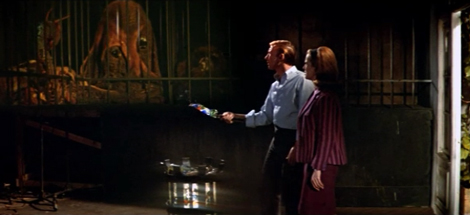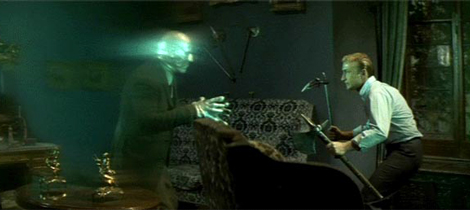|
|
Reviewed by Glenn Erickson
The early and middle 1960s were the real boom years for American-International Pictures, when their "Beach Party" movie series was pulling down high rentals and Vincent Price horror pictures were being reviewed as prestige productions. A.I.P. opened a Television division and made their European co-productions official by establishing a base of operations in England.
The Roger Corman/Vincent Price series of Edgar Allan Poe chillers did so well that A.I.P.'s James Nicholson and Samuel Arkoff spent the latter half of the 1960s looking for similar material. They found it in the legendary horror author H.P. Lovecraft, whose grim stories often took place around a town called "Arkham". Many shared Lovecraft's self-generated "Cthulhu" mythology, that proposes that what we think of as reality is just a thin, unstable veneer: in a subterranean lair (perhaps in an alternate dimension) a race of indescribably evil and inscrutable creatures awaits their moment to erupt into our world. Although presumed to have the intention of establishing a reign of horror their motives, intentions, desires, etc. are utterly alien and unknowable to the human mind. Running out of ideas for Poe movies, Roger Corman had trod on Lovecraft territory, with Vincent Price playing a madman conducting hellish experiments at a well-like entrance to the Lovecraftian domain of demons. As was typical of their commercial conservatism, A.I.P. got cold feet and marketed the movie as Edgar Allan Poe's The Haunted Palace (1963).

1965's Die, Monster, Die! is therefore the second H.P. Lovecraft film to be acknowledged in its credits. Roger Corman's designer Daniel Haller had been responsible for the high gloss / low budget look of the Poe series, and on this show was promoted as director. The genuinely frightening and unrelentingly grim source tale The Colour Out of Space is one of Lovecraft's best. First published in 1927, it was reprinted in anthologies long before the author became a cult figure.
Die, Monster, Die! was filmed at Shepperton Studios with exteriors in Surrey. Young Stephen Reinhart (Nick Adams) shows up in the town of Arkham looking for the old Witley house, and is refused directions by the locals. Walking the several miles alone, Stephen sees that the surrounding area is covered with dead, wilted vegetation, as if some blight were on the land. Wheelchair-bound Nahum Witley (Boris Karloff) turns Stephen away, but young Susan Witley (Suzan Farmer) welcomes the visitor. Nahum refuses to acknowledge Susan's romance with the outsider, and expects her to stay home out of loyalty. Nahum's bedridden wife Letitia (Freda Jackson) remains upstairs, suffering from some unknown malady. Despite Nahum's protests, Stephen and Susan investigate. They find that her father has been using the strange powers of mysterious green rocks to grow enormous vegetables in the greenhouse. But the side effects are monstrous: former barnyard animals are now disgusting, shapeless monsters kept caged in a dark room. And Nahum has been tending to a subterranean well from which emanates strange lights. We hear of another Witley, now dead, who worshipped demons at the well, but the green rocks seem to have come from a meteorite. The family valet Merwyn (Terence de Marney) dies mysteriously, and Leticia's tissues seem to be slowly dissolving as well. Nahum clings to the notion that the green rocks are beneficial. Then green patches appear on his skin as well...
TV writer Jerry Sohl reshapes Lovecraft's atmospheric mood piece into a more conventional horror movie drama, much as screenwriter Richard Matheson had done for Poe's The Fall of the House of Usher. The original The Colour Out of Space manages a thoroughly chilling mood of decay and doom, as we hear about an entire farming family succumbing to a pernicious living rot. Lovecraft was fond of lengthy, grim descriptions of "indescribable" creatures and sensations. His story introduces the idea that the meteorite gives off a color never before seen -- something a good writer can suggest, whereas a filmmaker is forced to present an exact hue. In place of the story's humble farmhouse, the Witleys live in an Usher-like mansion. The characters' behavior is consistently awkward. Stephen Reinhart is unaccountably unperturbed by the wholly suspicious goings-on in the Witley manor. Recently returned from school, the wholesome Susan is equally comfortable to find that her mother is a raving madwoman suffering from a terrible, disfiguring malady. Stephen gets a close-up look at a trio of blobby, tentacled mutations but merely accepts them at face value. Nobody presses to call more doctors, or the police, or to make tracks away from what is obviously a very malignant place.

With his authoritative presence Boris Karloff makes the self-contradictory Nahum as believable as anyone could, but director Haller doesn't find a way for the characters to interact naturally. Nahum is shocked when his daughter and her beau discover things at the Witley house, which a meter reader would easily stumble over. Nahum insists that the green rocks can cure his wife and make the land bloom again, with only his jumbo tomatoes to support the notion. In the book the 'colour' from the meteorite grew impressive but noxiously inedible plants. One by one, the Witley family members went insane and were locked in their rooms, where they physically fell apart, like rotting fruit. The inference is that the emanations from the meteorite warped Nahum's judgment, and a kind of festering inertia set in.
Die, Monster, Die! makes only a few gestures toward Lovecraft-style atmospherics, with a matte painting or two failing to establish the idea of Nahum's land blighted under an uncanny rot. (Curiously, just a shot or two of Mark Damon riding a horse through a recently burned wood nails the same idea in Corman's House of Usher.) Not content with its cursed meteorite, Die! repeats the Cthulhu mythos concept direct from The Haunted Palace: the evil things happening to the Witleys also have something to do with the worship of dark underworld gods.
Jerry Sohl also scripted an adaptation of Lovecraft's Dreams of the Witch House that later formed the basis for Curse of the Crimson Altar, also with Boris Karloff. Sohl receives a screen credit for "story", while poor Lovecraft isn't mentioned at all! The script for Die, Monster, Die! does manage a jolt or two in every reel, as Stephen and Susan repeatedly traverse the estate unraveling the grim Witley secrets. The most shocking sight is the demise of a main character, whose head and face seem to collapse into glowing green mush before our very eyes. Helping in this regard are some handsome visuals from Wally Veevers and Ernie Sullivan, and a weird set of main titles designed by Les Bowie.
As becomes apparent in all of his work from this film forward, Boris Karloff is almost completely restricted to his wheelchair. The actor's lack of mobility may have influenced the shape of the story, as it would seem impossible for Karloff to perform actively in flashbacks showing the discovery of the fallen meteorite, etc. Fans expressed some disappointment when a final transformation turns Karloff into a glowing, misshapen creature -- an all-too-obvious substitution of actors takes place.

Die, Monster, Die! really does play like House of Usher intercut with a few seconds of sci-fi monsters and demonic dungeons. Nick Adams would appear in a pair of adolescent Japanese fantasies, Frankenstein Conquers the World and Invasion of Astro-Monster. Boris Karloff returned in at least two more significant horror outings, Michael Reeves' clever The Sorcerers and Peter Bogdanovich's brilliant Targets. Director Daniel Haller would take another wild stab at H.P. Lovecraft with 1970's The Dunwich Horror.
The Scream / Shout! Factory Blu-ray of Die, Monster, Die! is a beautiful HD transfer of this richly-colored picture; one suspects that director Haller kept a close eye on the visual designs. The extra resolution makes the title sequence pop while doing no favors for some of the matte paintings. But other illusions, such as the added enormous fruits in the greenhouse, are quite good. The brief view of the caged mutations is so promising that it leaves us wishing the critters played a larger role in the storyline. They look like cousins to the extraterrestrial creature in The Quatermass Xperiment.
The Blu-ray offers no extras. We're told that in 1965 Die, Monster, Die! was co-billed with A.I.P.'s Italian co-production Planet of the Vampires, directed by Mario Bava. Now that would have been an impressive double bill to see back in the day.
On a scale of Excellent, Good, Fair, and Poor,
Die, Monster, Die! Blu-ray rates:
Movie: Good -
Video: Excellent
Sound: Excellent
Supplements: none
Deaf and Hearing Impaired Friendly?
N0; Subtitles: None
Packaging: Keep case
Reviewed: December 26, 2013

DVD Savant Text © Copyright 2013 Glenn Erickson
See more exclusive reviews on the Savant Main Page.
Reviews on the Savant main site have additional credits information and are often updated and annotated with reader input and graphics..
T'was Ever Thus.
Return to Top of Page
|

